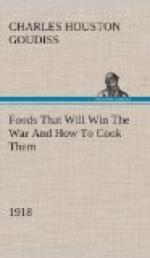There are various methods of conserving fat. First, the economical use of table fats; second, the saving of cooking; and third, the proper use of all types of fat.
Economy in the use of table fats may best be secured by careful serving. One serving of butter is a little thing—there are about sixty-four of them in a pound. In many households the butter left on the plates probably would equal a serving or one-fourth of an ounce, daily, which is usually scraped into the garbage pail or washed off in the dishpan. But if everyone of our 20,000,000 households should waste one-fourth of an ounce of butter daily, it would mean 312,500 pounds a day, or 114,062,500 pounds a year. To make this butter would take 265,261,560 gallons of milk, or the product of over a half-million cows, an item in national economy which should not be overlooked.
When butter is used to flavor cooked vegetables, it is more economical to add it just before they are served rather than while they are cooking. The flavor thus imparted is more pronounced, and, moreover, if the butter is added before cooking, much of it will be lost in the water unless the latter is served with the vegetables. Butter substitutes, such as oleomargarine and nut margarine, should be more largely used for the table, especially for adults. Conserve butter for children, as animal fats contain vitamines necessary for growing tissues. Butter substitutes are as digestible and as nourishing as butter, and have a higher melting point. They keep better and cost less.
Oleomargarine, which has been in existence for fifty years, was first offered to the world in 1870 by a famous French chemist, Mege-Mouries, who was in search of a butter substitute cheap enough to supply the masses with the much-needed food element. He had noticed that the children of the poor families were afflicted with rickets and other diseases which could be remedied by the administration of the right amount of fat. He combined fresh suet and milk and called the product “oleomargarine.” In the United States this product is now made of oleo oil or soft beef fat, neutral lard, cottonseed and other oils, churned with a small quantity of milk, and in the finer grades, cream is sometimes used. A certain proportion of butter is usually added, and the whole worked up with salt as in ordinary butter-making.
Owing to the fears of the butter-makers that oleomargarine would supplant their product in popular favor, legislation was enacted that restricted the manufacture of oleo and established a rigid system of governmental inspection, so that the product is now manufactured under the most sanitary conditions which furnishes a cleaner and more reliable product than natural butter.
Nut margarine is a compound of cocoa oil, which so closely resembles butter that only an expert can distinguish it from the natural product. Both these butter substitutes are used in large amounts by the best bakers, confectioners and biscuit manufacturers, and foolish prejudice against butter substitutes should not deter their use in the home.




